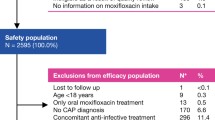Abstract
In two prospective, randomized studies intravenous (IV)/oral (PO) moxifloxacin (400 mg q.i.d.) was compared to IV/PO antimicrobial comparator agents for the treatment of hospitalized patients with community-acquired pneumonia. Reported here are the pooled data for the sub-population with atypical pathogens. Of 101 intent-to-treat patients with atypical pathogens, a total of 39 moxifloxacin-treated and 47 comparator-treated subjects were microbiologically valid and included in the analysis. Clinical and bacteriological success rates were 95% for the moxifloxacin-treated and 94% for the comparator-treated subjects at the test-of-cure visit. The results indicate IV/PO moxifloxacin (400 mg q.i.d.) is an effective monotherapy for patients with CAP due to atypical pathogens.
Similar content being viewed by others
References
Plouffe JF (2000) Importance of atypical pathogens of community-acquired pneumonia. Clin Infect Dis 31(Suppl 2):35–39
File TM Jr, Tan JS, Plouffe JF (1998) The role of atypical pathogens: Mycoplasma pneumoniae, Chlamydia pneumoniae, and Legionella pneumophila in respiratory infection. Infect Dis Clin North Am 12:569–592
Lim WS, Macfarlane JT, Boswell TC, Harrison TG, Rose D, Leinonen M, Saikku P (2001) Study of community acquired pneumonia aetiology (SCAPA) in adults admitted to hospital: implications for management guidelines. Thorax 56:296–301
Ruiz-Gonzalez A, Falguera M, Nogues A, Rubio-Caballero M (1999) Is Streptococcus pneumoniae the leading cause of pneumonia of unknown etiology? A microbiologic study of lung aspirates in consecutive patients with community-acquired pneumonia. Am J Med 106:385–390
Porath A, Schlaeffer F, Lieberman D (1997) The epidemiology of community-acquired pneumonia among hospitalized adults. J Infect 34:41–48
Marrie TJ, Peeling RW, Fine MJ, Singer DE, Coley CM, Kapoor WN (1996) Ambulatory patients with community-acquired pneumonia: the frequency of atypical agents and clinical course. Am J Med 101:508–515
Marston BJ, Plouffe JF, File TM Jr et al (1997) Incidence of community-acquired pneumonia requiring hospitalization: results of a population-based active surveillance study in Ohio. Community-Based Pneumonia Incidence Study Group. Arch Intern Med 157:1709–1718
Mandel LA (2000) Guidelines for community-acquired pneumonia: a tale of 2 countries. Clin Infect Dis 31:422–425
Mandell LA, Bartlett JG, Dowell SF, File TM Jr, Musher DM, Whitney C, Infectious Diseases Society of America (2003) Update of practice guidelines for the management of community-acquired pneumonia in immunocompetent adults. Clin Infect Dis 37:1405–1433
Niederman MS, Mandell LA, Anzueto A et al (2001) Guidelines for the management of adults with community-acquired pneumonia. Diagnosis, assessment of severity, antimicrobial therapy, and prevention. Am J Respir Crit Care Med 163:1730–1754
Finch R, Schurmann D, Collins O et al (2002) A randomized controlled trial of sequential intravenous (IV) and oral moxifloxacin compared with sequential IV and oral co-amoxiclav with or without clarithromycin in patients with community-acquired pneumonia requiring initial parenteral treatment. Antimicrob Agents Chemother 46:1746–1754
File TM, Larsen LS, Fogarty CM et al (2001) Safety and efficacy of sequential (IV to PO) moxifloxacin for the treatment of community-acquired pneumonia in hospitalized patients. Todays Ther Trends 19:251–270
Niederman MS, Bass JB, Campbell GD et al (1993) Guidelines for the initial management of adults with community-acquired pneumonia: diagnosis, assessment of severity, and initial antimicrobial therapy. Am Rev Respir Dis 148:1418–1426
Norrby SR, Petermann W, Willcox PA et al (1998) A comparative study of levofloxacin and ceftriaxone in the treatment of hospitalized patients with pneumonia. Scand J Infect Dis 30:397–404
Ruiz M, Ewig S, Torres A et al (1999) Severe community-acquired pneumonia. Risk factors and follow-up epidemiology. Am J Respir Crit Care Med 160:923–929
Acknowledgments
We wish to thank all of the dedicated investigators who participated in the multinational and the North American clinical trials. We also thank B. Shearer and T. Tartaglione for editorial contributions. All experiments were performed in compliance with the current laws of the country in which they were conducted. This work was supported by a research grant from Bayer Pharmaceuticals Corporation, West Haven, CT, USA.
Author information
Authors and Affiliations
Corresponding author
Rights and permissions
About this article
Cite this article
Hoeffken, G., Talan, D., Larsen, L.S. et al. Efficacy and safety of sequential moxifloxacin for treatment of community-acquired pneumonia associated with atypical pathogens. Eur J Clin Microbiol Infect Dis 23, 772–775 (2004). https://doi.org/10.1007/s10096-004-1214-5
Published:
Issue Date:
DOI: https://doi.org/10.1007/s10096-004-1214-5




